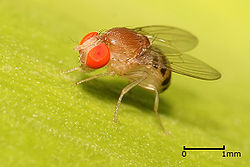
| Home | Sources Directory | News Releases | Calendar | Articles | | Contact | |
Drosophilidae
| Drosophilidae | |
|---|---|
 |
|
| Drosophila sp. | |
| Scientific classification | |
| Kingdom: | Animalia |
| Phylum: | Arthropoda |
| Class: | Insecta |
| Order: | Diptera |
| Suborder: | Brachycera |
| Section: | Schizophora |
| Subsection: | Acalyptratae |
| Superfamily: | Ephydroidea |
| Family: | Drosophilidae |
| Subfamily | |
| Wikispecies has information related to: Drosophilidae |
Drosophilidae is a diverse, cosmopolitan family of flies, including the genus Drosophila, which includes fruit flies. The best known species is Drosophila melanogaster, which is used extensively for studies concerning genetics, development, physiology, ecology and behaviour. The fruit fly is mostly composed of post-mitotic cells, has a very short lifespan, and shows gradual ageing. As in other species, temperature influences the life history of the animal. Several genes have been identified whose manipulation extends the lifespan of these animals.
Contents |
[edit] Economic significance
Generally, drosophilids are considered nuisance flies rather than pests, since most species breed in rotting material. Zaprionus indianus Gupta is unusual among Drosophilidae species in being a serious, primary pest of at least one commercial fruit, figs in Brazil.[1] Another species, Drosophila suzukii, infests thin-skinned fruit such a raspberries and cherries and can be a serious agricultural pest.[2] Drosophila repleta larvae inhabit drains and spread bacteria.
[edit] Identification
The diagnostic characters for Drosophilidae include the presence of an incomplete subcostal vein, two breaks in the costal vein, and a small anal cell in the wing; convergent postocellar bristles; and usually three frontal bristles on each side of the head, one directed forward and the other two directed rearward. More extensive identification characteristics can be found in "Drosophila: A Guide to Species Identification and Use" by Therese A. Markow and Patrick O'Grady, (Academic Press, 2005) ISBN 0124730523 or "Drosophila: A Laboratory Handbook" by M. Ashburner, K. Golic, S. Hawley, (Cold Spring Harbor Laboratory Press, 2005).
[edit] Phylogeny
The knowledge of the phylogeny of this family is incomplete. The family is subdivided in two subfamilies, the Drosophilinae and the Steganinae. The two subfamilies do not contain a single morphological character that distinguishes them. However, the combination of characteristics is sufficient to assign species correctly to the subfamilies.
Most molecular phylogeny studies focus on the genus Drosophila and related genera. Recently, an overview of the more than 100 articles using molecular techniques has been published [3]
[edit] Gallery
|
Drosophilidae compound eye |
[edit] External links
| Wikimedia Commons has media related to: Drosophilidae |
[edit] References
- ^ "Pest Alerts - Zaprionus indianus Gupta, DPI". Florida Department of Agriculture and Consumer Services. http://www.doacs.state.fl.us/pi/enpp/ento/zaprionusindianus.html. Retrieved 2007-10-19.
- ^ Drosophila suzukii Center of Invasive Species Research
- ^ van der Linde, Kim; Houle, David (2008) A supertree analysis and literature review of the genus Drosophila and closely related genera (Diptera, Drosophilidae). Insect Systematics & Evolution 39(3): 241-267
|
SOURCES.COM is an online portal and directory for journalists, news media, researchers and anyone seeking experts, spokespersons, and reliable information resources. Use SOURCES.COM to find experts, media contacts, news releases, background information, scientists, officials, speakers, newsmakers, spokespeople, talk show guests, story ideas, research studies, databases, universities, associations and NGOs, businesses, government spokespeople. Indexing and search applications by Ulli Diemer and Chris DeFreitas.
For information about being included in SOURCES as a expert or spokesperson see the FAQ . For partnerships, content and applications, and domain name opportunities contact us.



